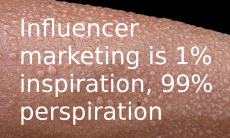Thursday, I spent an hour answering questions from Chris Keiff and others on Twitter in my first-ever Twitter interview. I’d done interviews in chat rooms, but this was different, because I had to confine my answers to one or two 140-character tweets. With permission, I extracted the conversation and tried to thread it to make sense, along with some light editing to expand abbreviations and fix typos. I hope you’ll find it useful, too.
Hello everyone and welcome to today’s Social Marketing Chat. Please welcome @MikeMoran, Author of “Do it Wrong Quickly.”
Me: Thanks, Chris. This looks like fun–it’s my first Twitter interview.
Mike, can you tell us a little about yourself and your book?
Sure. I have two books—one on search marketing co-authored with Bill Hunt and one on Internet marketing, including social. I led initiatives at ibm.com for eight years and now do public speaking and consulting as Chief Strategist for Converseon.
So how does Do it Wrong Quickly apply to social?
The book is about experimentation, and because social is free, it is a great place to experiment without the boss noticing.
But if we do it wrong, won’t the boss notice that?
Possibly, but the idea is to try a few different things so that the “wrong” ones are break-even and the “right”one is a win. Most bosses pay a lot more attention to money than time. And if you pick difficult problems and fix one, you’re a hero.
There is a lot of fear coming from bosses in social media. How can you overcome this?
If your boss is fear-driven, you might want to try scaring him more about NOT doing social media: We’re missing the boat and our competitors are leapfrogging us. How will you explain this to your boss when he asks why we are MIA on social?
But when we experiment, how do we know the wrong ones are going to be break-even?
Start out doing lower risk stuff. Don’t immediately break out that “hilarious” video that might offend folks. Instead, start with blogging, or Twitter, and do something really helpful to customers.
So, is it a bottom-up social media adoption strategy or top-down or both?
Depends on where you work. I have seen bottom-up work better but some enlightened companies have come from top. I think the best ends up being both before it really takes off. usually start at bottom and then top gets excited.
I agree. I think the bottom-up can provide the proof through experimenting to show the top. Then adoption grows.
I see it work that way all the time, but us at the bottom must be willing to take a personal risk for it to happen.
What types of questions do you get on social marketing most frequently?
Mostly people have objections–I am not technical, I am no writer, my boss would never let us do this and ad nauseum. They really need is to get over their own fears of making mistakes and just try stuff. We all screw up until we succeed.
Is there a big difference between large and small companies and the issues they have?
Yes. Small companies think no one cares about them. Big companies think they can’t tell anything. Both are wrong. Both big and small companies are afraid of making mistakes and social media unfortunately demands them.
How can a small company get others to notice them via social?
Getting noticed is about being distinctive. Most small companies are local, but local doesn’t buy anything on the Internet. Small companies must find the thing that makes them unique. The expertise. The angle. What are they REALLY good at?
How do big companies determine what they can say and what they can’t say?
Mostly I advise them to bet on people rather than processes, which goes against every fiber in their being. They like rules. Companies must train folks to operate in public because divulging trade secrets on the phone ain’t better than on Twitter. Companies must trust their people to do the right thing in social media, just as they trust them in other public venues.
How can you convince a corporation to trust people rather than process?
One way is that they get desperate enough that they realize no rules can control this and they have to trust people.
Mike, do you have any favorite examples of big brands doing well with social media?
Dell is doing a great job of crowdsourcing with IdeaStorm. Graco has a top-rated Mommy presence. Lion Yarn is a good small company example, with a blog that just won a Forrester Groundswell award (http://blog.lionbrand.com/). And, Will It Blend is a classic.
Do their products rock? Do they know where their clients are? Are they ready to interact with others?
Those are great questions every company must ask. That’s why the best social media starts with listening.
How are they successful in social media?
Every company must have its own goals for social. One client is selling on Twitter. Others are doing PR. Each use case needs different measurements ranging from sales to improvement in brand awareness.
Good point. It’ll be helpful to find more tangible case studies as social media grows, especially for those new to it. What trends are you seeing as social media evolves? Are the trends different between small and large companies?
The clients I am working with now are focused on different kinds of ROI and those stories are emerging soon. Biggest trends: Listen first and ROI tracking. Listen to the conversation before you speak. Make the value count.
How do search marketing and social marketing work together?
Social is a great way to get those cherished one-way links that are golden in organic search. But social also helps content. The content most helpful to customers is not only great as social media passalong but also attract those one-way links.
Can you expand on the idea of good content for customers and SEO?
No one cares about your product catalog page. Write articles about how customers solve problems, with your product as one way. Help your customers with information they need and you’ll benefit in search and social. Enough will remember to buy from you.
How tangible and accountable are the ROI measurements? Varies greatly depending on touch points?
Varies a great deal. One client is actually tracking sales starting at Twitter to offline CRM very accountable. Other clients tracking how many views on YouTube. Not all that exciting as ROI, right? Clients vary in maturity.
Makes me curious how correlation models will develop over time.
Agreed. Expect to see people using social media for predictive modeling next. It’s exciting stuff.
Mike, where can we hear you speak next?
I’ll be at Search Insider Summit and Enterprise Social in Amsterdam http://www.mikemoran.com/aboutmike/speeches.htm
Mike, where can we find your books and more of your thoughts?
Thanks for the plug, Chris. Both of my books and my Biznology blog and newsletter are at http://www.mikemoran.com
Thank you Mike and everyone for joining us.
Thanks Chris. This was great fun. And thanks to everyone who asked questions or just listened in.

![Reblog this post [with Zemanta]](http://img.zemanta.com/reblog_e.png?x-id=0221013d-4768-4c39-8f9e-7222a72c10ff)




